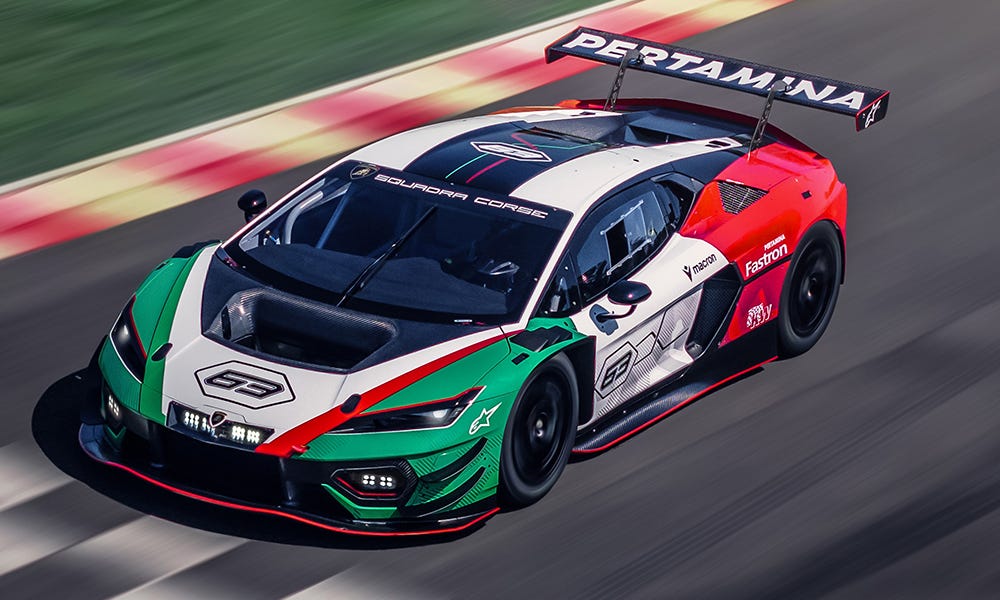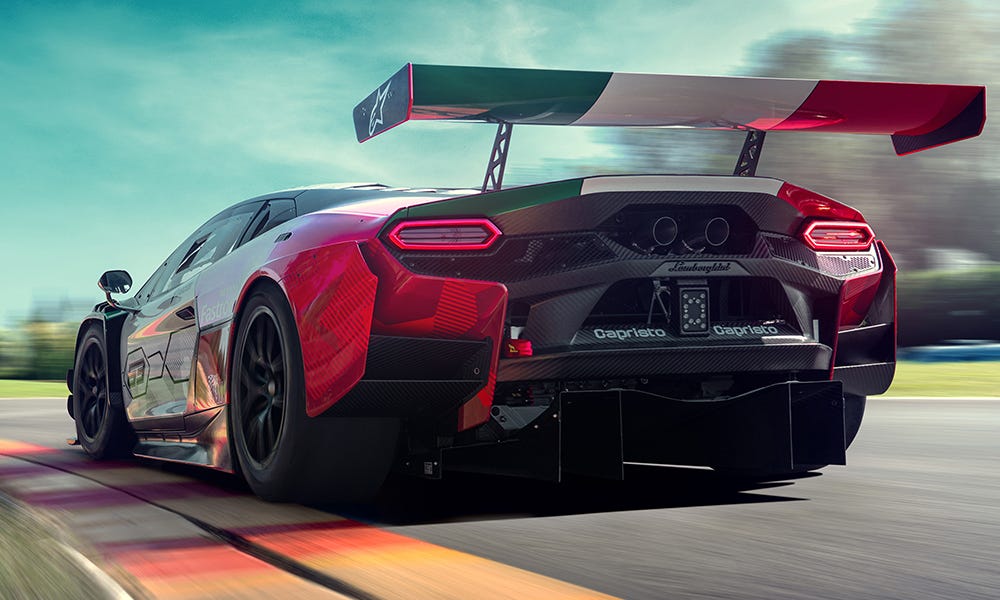Insight: Inside Lamborghini’s First Clean-Sheet GT3 Car
Lamborghini chief technical officer Rouven Mohr on Temerario GT3’s key enhancements…
There’s no denying the Lamborghini Huracan GT3 has been one of the most successful GT3 cars since its launch ten years ago. With more than 200 units produced and nearly 100 titles achieved in championships around the world, it’s been one of the “go to” cars for professional teams and gentlemen drivers alike.
The Italian manufacturer, however, hasn’t been resting on its laurels, with Friday’s unveil of the Temerario GT3, which is set to make its race debut next year and feature a number of lessons learned from Lamborghini Squadra Corse’s first-ever GT3 car from a decade ago.
While having been through two evolutions since then that set the car apart from its sister brand, the Huracan GT3 initially shared the platform the Audi R8 LMS, providing Lamborghini with a relatively easy entrance into the GT3 marketplace.
This time around, the Temerario GT3 is Lamborghini’s first competition model entirely designed, developed and built at Sant'Agata Bolognese.
However, according to Lamborghini technical director Rouven Mohr, the decade of the Huracan GT3 and the significant updates the brand made with the EVO and EVO2 versions of the car has made Lamborghini well-prepared for its latest venture.
"The basic concept of the car is quite similar to what we have in the moment with the Huracan because we wanted to have, in the end, a car that should be sold,” says Mohr. "There are other GT3 cars in the field -- I will not give you names -- but they have such high pricing or the manufacturer is only interested in selling the [FIA] minimum of 20 cars and then that's it.
"For us, it's really still, and really also the future, a business case. It's clear that therefore we designed the car to be competitive but also that the car is from the running costs, from the price, and also from the maintenance point of view, attractive for the customer.
"For us it's a little bit easier because our street car is already a very good base. For sure it's always more difficult if you're coming more from a coupe, a limousine-style car to make a race car. You need much more dramatic changes in the concept.
"This was not needed on our car, nor the Huracan.”
Arguably the biggest change from the Huracan GT3 is the engine, with the 5.2-liter normally aspirated V10 replaced by a brand-new four-liter twin-turbo V8 powerplant, which shares most of the components from its road-going version.
That is, as Mohr points out, except the hybrid system, which is not legal in GT3 competition, as well as the use of a smaller turbocharger to account for the reduced power output as regulated in the FIA-based platform.
"We followed the recipe of the Huracan that we started really with a one-to-one street engine, from the engine's architecture point of view,” says Mohr. "Then for sure, you have to remove the hybrid system, since it's a non-hybrid race formula, and then if you remove the hybrid system you have to anyhow, independent from the Balance of Performance window, you have to [reduce] the turbocharger.
"It's clear; on the street car, the turbocharger is [big]. The race car, because it's not needed and it's not working without the electrification, a turbocharger is technically smaller. You kind of have the downsizing of the street engine.
"Also the rev limit, it doesn't make sense that the race engine is revving up to 10,000 [rpm] because we don't need this power. In this car, we operate in the power window between 500-600 hp, depending on the BoP.
"In the street car, only the combustion engine has 800 [hp]. As you can imagine, there's a lot of downsizing needed. But the pistons, the conrods, the camshaft, the engine block, everything is one-to-one street car.”
The move to a turbo engine will also have some added benefits in raceability.
"On the turbo side, we overcame our main problem of the current car,” explains Mohr. “The current Huracan is a super race car; it's good on the brakes, it's fast rotating in and in the corners always good.
"The disadvantage, for sure, the raceability with a naturally aspirated [engine] and our air box on the roof that we introduced in the EVO2 concept, we have a little bit of trouble if you want to overtake. Because in the slipstream, it's OK. If you go out of the slipstream, we don't have the possibility to manage the torque in the right moment because it's naturally aspirated.
"With the turbo engine for sure, you have a lot more opportunities to manage the boost management and to always have more torque available. With the naturally aspirated one, the driver has to be very precise on the shifting point, and if it's not fitting 100 percent, you see that sometimes we struggle in some situations.
"This will be, for sure, removed in the new car.”
While there are some other clear differences to the Temerario road car, such as the use of an air-to-air intercooler system for the GT3 car, compared to a water-to-air system, Mohr says they’re able to take advantage of the latest generation control units for engine mapping, traction control and ABS.
This will also benefit the Temerario GT3 in series, such as the IMSA WeatherTech SportsCar Championship, that mandate torque sensors, because the Huracan GT3 platform was not originally designed to integrate such power control technology.
The Temerario utilizes a six-speed sequential gearbox, per GT3 rules, although in a transverse design, which Mohr says will have benefits to other areas of the car, which is still under development.
“This is a big advantage for the management of the airflow of the diffuser and the underbody on this car is working much more,” he says of the transverse gearbox design.
"Some of the journalists ask that the aero over the car doesn't look super aggressive. First of all, it's the presentation configuration, so we're still working on the aero package, so you can expect that it's not the final one. The final one we'll see after the homologation period and we still have some months to go.
"With newer GT3 cars, the magic is on the underbody. To define the ride height window, the underbody works in a perfect way. We have spent a lot of effort in the Sauber wind tunnel that is [now] part of Audi.”
The increased stiffness of the Temerario GT3’s chassis, fitted with the FIA-certified roll cage, offers better serviceability for its customers, in a similar fashion to that of the Type-992 Porsche 911 GT3 R and Ferrari 296 GT3, which were released in 2023.
"On the rear and front ends, we now have mounting concepts where you can easily exchange in case of a crash,” says Mohr. “This was already foreseen when we started the street car [design] because it was from the beginning that the street car will also have a sister or brother that will go into racing.
"Therefore, when you design the body-in-white for the street car, we already considered what would be the right interface for it, to have these kind of exchange and repair possibilities.”
Mohr adds: "We took a lot of care on the options to repair the car in case of crashes. The current car is more ascended like a street car, so you have a bumper, the front fenders. You have a lot of single parts.
"For instance, the front splitter, you have to manage with different adjustment opportunities. It works but it also generates trouble, especially to customer teams because our current car, if it's not in the perfect window regarding ride height, splitter configuration, etc, you'll lose completely the peak of the performance window.
"The new car is much more robust. We have the front end that you can remove, the rear end you can remove. More-or-less what you know from other GT3 cars that have been presented in the last three or four years.
"In this context, the development of the competition and the professionalism of the cars, for sure, is not comparable any more ten years ago when the Huracan was born. We closed the gap to the competitors. We have the latest state-of-the-art repairing options and also how easy it is for the customer teams to have a robust performance window.
"In the right window, the [Huracan] is still super competitive. If it's a little bit out of the window, you are not nowhere but you lose a lot of [performance]. The robustness is for sure a big improvement."
Another advancement comes in the suspension, with the Huracan GT3’s four-way adjustable dampers replaced by six-way units on the Temerario GT3.
"It's something that is helping the customer teams to have the perfect setup for the ride,” says Mohr. “Also, it [improves] the drivers' feeling because the current one is a bit limited. Therefore also sometimes, you see in the Huracan, the gentlemen drivers sometimes do a little bit harder than the pro drivers because the car is very agile and it rotates a lot, you have to work a lot on the brake. If you turn in, you cannot over-run the front axle too much.
"The pro driver is super happy with this behavior because they can position the car. The gentleman driver sometimes says it a bit differently, for the drivability.”
Gentlemen drivers will also benefit from improved ergonomics in the cockpit, primarily with visibility and increased ventilation.
“The step we did from the street car Huracan to the street car Temerario, regarding visibility, it's much improved because the Huracan, even if you only sit in the car, you have this double a-pillar and a very closed line of the roof,” says Mohr. “I wouldn't say it's claustrophobic with the Huracan, but for sure, if you compare it to other cars like the BMW or the Porsche, for sure the visibility is better.
"This is also something that’s good for the street car, but if you're doing racing, it's an additional stress factor because you're not seeing so good out of our car, and therefore this is also an improvement in the next generation with the Temerario.”
While still being a brand-new car, Mohr admits that a number of lessons have been taken from the Huracan.
“We have been orienting ourselves on the strength of the existing car,” he says. "Because the car is quite a good race car, everything started from this starting point. Based on this, we made the adjustments based on the specifics of this [new] car.
"I would not say it's been a huge change for sure. What is now at the moment, it's the first time we're doing the management of the boost controller as it was not needed on the Huracan. This was completely new for us in the race car.
“[But] these are the same people that are working on the street car. Lamborghini Squadra Corse is not an external company. We have many people that work on the street project and now work on the race project.
"On the rest of the car, we've collected more than ten years of experience with the Huracan and the platform is not so super different.”
Given the Huracan GT3’s track record, expectations are high for its successor, with Lamborghini Squadra Corse appearing to have all of the key ingredients in place to continue its winning legacy, as well as being a leading option for GT3 customers worldwide.
Photos: Lamborghini









Excellent article as always